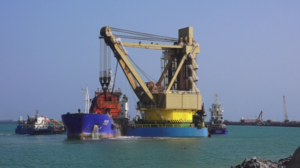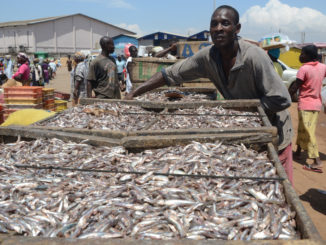APM Terminals is investing billions of dollars in West Africa seaports – but not in Lagos, the current (and much-maligned) container port hub for the region.
In Liberia, Maersk’s terminal division has put $110 million into its port at Monrovia in line with a concession agreement with the government. According to country director George Adjei, these expenditures include $50 million for wharf improvements and $60 million for equipment. The investment is already near the total amount that APMT promised to put into the port over the entirety of its 25-year lease, according to local outlet Liberian Observer.

APMT and its partners are also spending $1.5 billion on a greenfield multi-purpose port in Tema, Ghana, located on a site adjacent to the current seaport. Tema’s port handles about 70 percent of Ghana’s trade, and it is overwhelmed by cargo traffic. The new facility will have 3.5 million TEU of capacity, 17 berths and enough depth for neopanamaxes of up to 13,000 TEU – many times larger than the biggest vessels that currently call at Tema. About 20 percent of the total investment will go not to the port, but to improvements to the highway that connects Tema with Ghana’s capital, Accra. Construction on the port is under way, and it is expected to open next year.
APMT also holds an existing lease at the Apapa terminal in Lagos, Nigeria, the busiest container terminal in all of West Africa. However, it has not announced major plans to invest in its operations there. Lagos is notoriously congested, due in large part to the unusually poor state of the Oshodi-Apapa Expressway. Potholes give sections of the highway the appearance of an offroad racetrack; gridlock is a near-permanent condition; and truck drivers routinely park their vehicles and take up residence in the road. When traffic is at its worst, car and minibus drivers have taken to driving on the wrong side, headed against the flow, in order to bypass jammed lanes. In July, Nigeria’s government reportedly blamed Maersk and Cosco for the congestion.
“Like many ports in Europe and the United States, Lagos grew from a port into a city and at some point, the limitations of that combination is reached,” said Peder Sondergaard, Africa-Middle East Region Head for APM Terminals, in a statement in August. To bypass these limitations, APMT said that it was negotiating with Nigeria’s government to build a $2.6 billion multipurpose facility at Badagry, 35 miles to the west of Lagos and 30 miles east of Cotonou, Benin.
Many Nigerian importers have begun to land their cargoes in Benin in order to avoid Lagos, especially since Cotonou Port has made significant improvements in productivity in recent years. A brand new port at Badagry would create a modern alternative to Lagos, but closer to market than Cotonou and located within Nigeria’s borders.
However, Maersk’s ambitions at Badagry face headwinds. Badagry’s free trade zone component received government approval in 2017, but little progress has been made since, and Drewry has noted that falling container volumes in Nigeria have undercut the business case for greenfield port projects in the region. Even if it were built, the highway between Badagry and Lagos would not be much of an improvement over the Oshodi-Apapa: even Nigeria’s government admits that it is in a “deplorable state.”
The Badagry port development consortium’s website was online as recently as late August, but it is no longer available.
–
maritime-executive.com



